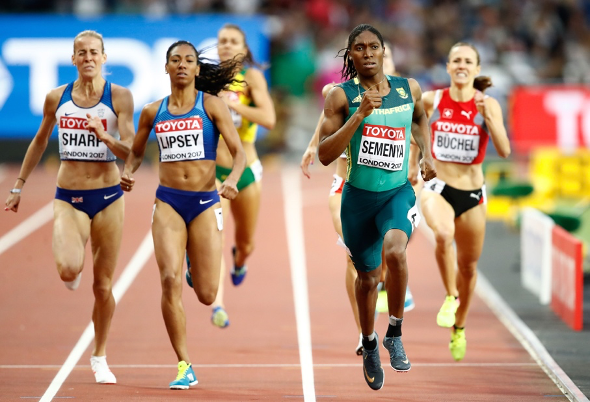By: Noah Shanholtzer
Intersex athletes’ participation in professional competitions has long been a controversy in the sports world. Specifically, women with the “46 XY DSD” gene variant, while identifying as female, are biologically considered males due to having internal testes.[1] Upon reaching puberty, instead of producing eggs, intersex athletes produce sperm and quantities of testosterone that cannot be matched by biologically female bodies.[2] In turn, along with developing male secondary sex characteristics (increased muscle mass and strength, increased heart size, and higher hemoglobin levels which result in better oxygen carrying capacity), women with the “46 XY DSD” gene variant have a testosterone level comparable to men.[3] A highly publicized case involves the South African middle-distance track-and-field champion: Caster Semenya.
In 2018, World Athletics, the track and field’s world governing body, issued new “Eligibility Regulations for the Female Classification (Athletes with Differences of Sex Development)” (DSD Regulations).[4] Upon this DSD Regulation, any female with the genetic variant “46 XY DSD” that wished to participate in the events of the 400m up to the 1 mile would have to lower their testosterone level below 5 nmol/L for six consecutive months prior to competing.[5] Following the implementation of this regulation, Caster Semenya sought a judgment from the Court of Arbitration for Sport (CAS) to find the DSD Regulations unlawful and to prevent them from being brought into force.[6]
On April 30, 2019, CAS held that World Athletics’ DSD Regulations were essential to ensure “the integrity of female athletes.”[7] After determining that Semenya had met her burden in proving that the DSD Regulations constituted discrimination, the burden of proof switched to World Athletics to establish that the regulations were nonetheless “necessary, reasonable and proportionate.”[8]
In finding the regulations necessary, CAS held that even though Semenya averages a 1.03% margin of victory ahead of second place (not a statistical outlier), her alleged 1.6% competitive advantage over female athletes without DSD (men have 10-12% advantage) provides her with a significant edge that necessitates the DSD Regulations to maintain fair competition.[9] In addition, while expressing doubts about the application of the regulations, CAS ultimately decided that the regulations were reasonable and proportionate, thereby upholding the DSD Regulations.[10]
Despite CAS admitting to the discriminatory nature of the DSD Regulations, on August 25, 2020, the Swiss Federal Tribunal (SFT), the highest court in Switzerland, dismissed Caster Semenya’s appeal against the decision of CAS.[11] Under a confined scope of review, SFT was limited by law to the question of whether CAS’ decision violated “fundamental and widely recognized principles of public order,” to which they answered ‘no.’[12] In doing so, SFT attempted to rationalize its opinion by insisting that the examinations from “qualified doctors” and the notion that no female athlete was being forced into a decision was “compatible with the guarantee of human dignity.”[13] Thus, by affirming CAS’ ruling, it is clear that the “legitimate concern” of “fairness in sport” was prioritized over all the women similarly situated to Caster Semenya.[14]
On top of their dignity and bodily integrity being discriminated against, intersex athletes are now forced to make life altering decisions about their body.[15] To reach the requisite level of testosterone necessary to compete in the 400m to the 1 mile race, the DSD Regulations provide the athletes with the option of a surgery to remove their internal testes, or hormone-suppressing drugs.[16] Besides the fact that a surgery is remarkably invasive, it is also dangerous.[17] Likewise, while hormone-suppressing drugs may not be as severe, they still cause “medically unnecessary physiological change.”[18]
Any potential judgment would have been considered unjust to someone; SFT simply chose to employ a utilitarian approach in burdening the minority.[19] There were a number of less intrusive options that could have been enacted to ensure continued intersex representation on the world’s biggest stage.[20] For one, non-intersex athletes could have been allowed to take performance-enhancing substances (up to 40% of elite athletes are currently doping anyways).[21] Moreover, instead of dividing events by biological sex, a new system could have been implemented that categorized athletes based on their testosterone levels.[22] Yet, with this decision, it is evident that “sports fairness” is ultimately valued more than human rights.[23]
[1] Doriane Coleman, Sex, Sports, and Why Track and Field’s New Rules on Intersex Athletes Are Essential, N.Y. Times (Apr. 20, 2018), https://www.nytimes.com/2018/04/30/sports/track-gender-rules.html.
[2] Id.
[3] Id.; see Press Release, World Athletics welcomes Swiss Federal Tribunal decision on its Eligibility Rules for Athletes with Differences of Sex Development (DSD), World Athletics (Sept. 8, 2020), https://www.worldathletics.org/news/press-releases/swiss-federal-tribunal-ruling-dsd-rules.
[4] Press Release, Swiss Federal Supreme Court, DSD Regulations: Caster Semenya’s appeal against the decision of the Court of Arbitration for Sport dismissed (Sept. 8, 2020), https://www.bger.ch/files/live/sites/bger/files/pdf/en/4A_248_2019_yyyy_mm_dd_T_e_18_18_10.pdf.
[5] Id.
[6] See Mokgadi Caster Semenya, Athletics South Africa v. Int’l Ass’n of Athletics Fed’ns, CAS 2018/O/5794 (Apr. 30, 2019) https://www.tas-cas.org/fileadmin/user_upload/CAS_Award_-_redacted_-_Semenya_ASA_IAAF.pdf.
[7] Id.
[8] Id.
[9] Id.
[10] Id.
[11] See Press Release, DSD Regulations: Caster Semenya’s appeal against the decision of the Court of Arbitration for Sport dismissed, supra note 4.
[12] Id.
[13] Id.
[14] Megha Mohan, What Caster Semenya IAAF discrimination case means for women and sport, BBC News (May 1, 2019), https://www.bbc.com/news/world-africa-48120228.
[15] U.N. High Commissioner, Intersection of race and gender discrimination in sport: Rep. of the U.N. High Commissioner for Human Rights, ¶ 34(b), U.N. Doc. A/HRC/44/26 (June 15, 2020).
Human Rights Council, Intersection of race and gender discrimination in sport 8-10 (2020), https://www.sportsintegrityinitiative.com/human-rights-council-urges-states-to-prohibit-dsd-rules/.
[16] See Press Release, DSD Regulations: Caster Semenya’s appeal against the decision of the Court of Arbitration for Sport dismissed, supra note 4.
[17] Geneva Abdul, This Intersex Runner Had Surgery to Compete. It Has Not Gone Well, N.Y. Times (Dec. 16, 2019), https://www.nytimes.com/2019/12/16/sports/intersex-runner-surgery-track-and-field.html. Annet Negesa, a three-time national champion and gold-medalist at the 2011 All-Africa Games, underwent surgery to lower her testosterone levels. Id. Years since her surgery, along with not being able to compete at the same level, Negesa still experiences persistent headaches and achy joints. Id.
[18] Coleman, supra note 1.
[19] See Abdul, supra note 11 (“[N]early seven in every 1,000 elite female athletes are intersex with levels of testosterone within the male range.”).
[20] Julian Savulescu, Ten ethical flaws in the Caster Semenya decision on intersex in sport, The Conversation (May 9, 2019), https://theconversation.com/ten-ethical-flaws-in-the-caster-semenya-decision-on-intersex-in-sport-116448.
[21] Id.
[22] Id.
[23] See Press Release, DSD Regulations: Caster Semenya’s appeal against the decision of the Court of Arbitration for Sport dismissed, supra note 4.



